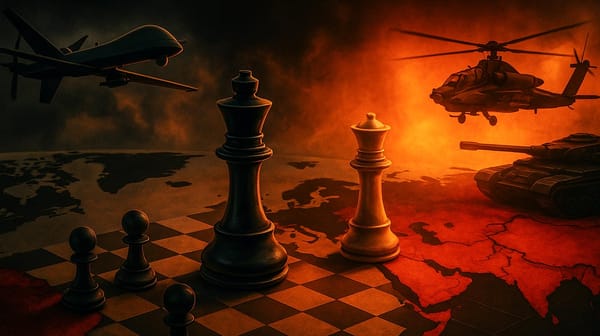How to Survive the Great Agency Extinction
As AI begins devouring marketing agencies, a select few are thriving—with a new kind of value creation.

The moment ChatGPT dropped in November 2022, marketers began to panic. We knew this revolutionary technology wasn't just game-changing ... it was possibly "game over" for agencies and the services they provided. Fast-forward two years, and the narrative is unfolding all around us. AI is bulldozing decades of hard-won client rosters and longtime agency relationships.
But surprisingly, in some corners of the industry, it’s opening up new possibilities and fueling growth. Beneath the lost retainers and frantic pivots, one constant remains: agencies that deliver real value still have a future. A bright one at that. The challenge, however, lies in uncovering new forms of value creation.
Let’s talk about a fashion retailer that ended its agency relationship once they discovered ChatGPT could effortlessly handle the bulk of their daily social posts and product captions. The brand’s internal social media manager told Digiday: “We were spending low five figures a month for basically short-form copy and scheduling. Now, we do it ourselves with ChatGPT and a few design templates. We haven’t seen engagement drop. In fact, we’re posting more often.” While the retailer admitted the quality of AI copy needed “human smoothing,” they said the cost savings were simply too big to ignore.
Meanwhile, a B2B software startup revealed a similar story. After testing generative AI for content production, they realized they no longer needed an agency. A spokesperson for the brand told Marketing Brew: “We realized the agency’s main deliverable—long-form blog posts and white papers—could be generated internally with GPT-4 plus our own subject-matter experts. We still believe in editorial polish, but we no longer need an entire external team.”
Then there’s BlueFocus, a massive Chinese marketing conglomerate that made headlines way back in 2023 after replacing hoards of external creative vendors with generative AI, triggering a widespread ripple effect.
And so it goes. In retail, in B2B SaaS, healthcare, hospitality, and beyond.
On the surface, these cautionary tales are depressing. And yet, not every agency is floundering. Take Codeword—a mid-sized marketing firm that saw the storm clouds gathering on the horizon. Instead of waiting to see if AI would gut their business, Codeword brought AI in-house. They hired what they jokingly called “AI interns,” integrated GPT-based systems into every corner of their workflow, and challenged employees to do more than just churn out deliverables. The result was a suite of brand-new AI-driven offerings that propelled Codeword onto the radar of major tech clients. By the end of the year, they had turned an existential threat into a competitive advantage.
Stories like this underscore a vital point. AI isn’t killing agencies simply because it’s faster, cheaper, or capable of pumping out reams of content. AI is killing agencies that haven’t redefined their value proposition. It’s still value creation—demonstrable, unique, and expensive to replicate—that draws the line between survival and extinction. The question is how to create it.
In a future where AI is a ubiquitous tool in every industry, four pillars of value creation will stand out for agencies determined to remain indispensable...
1. Differentiation
Before generative AI, producing mass content was a slog. That alone gave agencies leverage. Now it’s trivial, which means a flood of nearly identical content is washing over every social platform. The only way to avoid drowning is to craft a message so distinct that no competitor, human or machine, can mimic it. But differentiation isn’t just a one-off brand positioning exercise—it’s a perpetual effort to maintain consistency, pivot as needed, and constantly outmaneuver rivals. You help clients articulate exactly why they exist and what sets them apart, then weave that uniqueness into a brand narrative that infuses every piece of content, AI-generated or not. Agencies that steer this process, and do it well, are performing a vital task clients will pay for.
2. Process
Anyone can generate a 2,000-word blog post with a chatbot. And that's a problem. The winning move isn't just spitting out content, but engineering a process that elevates it beyond the ordinary. That might mean interviews with subject matter experts, internal data-gathering, or brand-specific story mining. When agencies transform these specialized ingredients into content that AI merely helps polish, they produce something uniquely valuable. Something their clients (and their clients' competitors) can’t easily replicate. It requires a strategic choreography of tasks across research, drafting, refinement, and final approval—a proprietary workflow that can make your agency an indispensable partner.
3. Distribution
Most clients assume the big challenge lies in creation, but half the battle is getting the right content in front of the right buyer at the right time—with the right next step. Distribution isn't just a one-way blast of content out into the ether. Done right, it's a well-choreographed layering of message strategy for every stage of the buyer journey across every channel that matters to your audience. In other words, for every piece of content, asking: "What do we want our audience to do next?" When an agency can guide the process of mapping a brand's content strategy to its buyer journey, there's real value in the exercise. And, like content production, it's not a one-and-done deal. Distribution is a continuous game of iteration and improvement, ideally suited to AI + human collaboration.
4. Mastery
There's more to piloting AI than pushing a button—and an agency's job is to prove it. Sure, a client can ask ChatGPT to write an email newsletter. But a master user might develop a repeatable process by developing a custom GPT, fed with carefully crafted brand guidelines, competitive positioning documents, and customer personas. She might create templates for reusable prompts that ensure consistency and high-quality writing that doesn't sound like generic AI speak. She may leverage AI to compile deep research reports that inform every issue. She might run the final draft through plagiarism checkers, cross check it with another LLM for factual accuracy, and manually smooth out the prose where needed. The point? Show clients that all AI users aren't created equal by pulling back the curtain. Help them see why doing it themselves won't bring the same results. Show them the value of AI mastery.
Marketing leaders who are ready to navigate the AI reckoning would be wise to examine their value proposition on each of these fronts. If you discover your team is mostly crafting content that ChatGPT, Claude, or Jasper can easily replicate, it’s time for a reinvention. If you rarely produce original insights—gathered from real interviews, custom data, or intangible brand truths—there’s no protective moat between you and the cheaper alternative. And if you can’t articulate why your masterful use of AI is more advanced than a client’s teenage nephew with a laptop, you should probably brace for a short future.
When the dust settles, the agencies left standing will be the ones that approached the AI revolution not as a threat, but as a challenge to step up. Because while AI can produce a mountain of content, it cannot replicate a nuanced sense of a brand’s soul. It can’t capture the distinctive wisdom of human subject matter experts. It can’t fine-tune distribution to capture the hearts of precisely the right audience, at precisely the right time. And it can’t demonstrate mastery to a client without the guiding hand of people who know how to orchestrate all of these moving parts.
In the end, value is the ultimate differentiator. If you, as an agency leader or marketer, can define that value, deliver it consistently, and show your clients that they can’t get it anywhere else—even with the latest LLM in their corner—then you’re writing your own future. Yes, agencies are closing. Yes, AI has changed everything. But for those who learn to excel in brand differentiation, proprietary processes, distribution strategy, and advanced AI mastery, the new era is an opportunity to stand out in a way that was never possible before.






